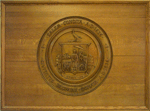Hathorne, John: Difference between revisions
From Salem Links and Lore
No edit summary |
No edit summary Tag: visualeditor |
||
| Line 1: | Line 1: | ||
*John Hathorne (1641-1717) was son of Major William Hathorne and author Nathaniel Hawthorne's (born Hathorne) great-great-great paternal grandfather. | *John Hathorne (1641-1717) was son of Major William Hathorne and author Nathaniel Hawthorne's (born Hathorne) great-great-great paternal grandfather. | ||
*He is best known, however as the "witch judge" or the "hanging judge" as he was a magistrate of the Court of Oyer and Terminer and the | * Justice John Hathorne was the third son of Major William and Anna Hathorne. He became a prosperous merchant in Salem and a judge on the Superior Court. He was also commander-in-chief against the Indians in 1696. | ||
chief interrogator of the accused witches in the Salem witchcraft hysteria of 1692. He was also known as the one who never repented his actions. | |||
*He is best known, however as the "witch judge" or the "hanging judge" as he was a magistrate of the Court of Oyer and Terminer and the chief interrogator of the accused witches in the Salem witchcraft hysteria of 1692. He was also known as the one who never repented his actions. | |||
*John Hathorne is interred at the [[Charter Street Burial Ground]] in Salem. | *John Hathorne is interred at the [[Charter Street Burial Ground]] in Salem. | ||
| Line 10: | Line 9: | ||
*In Arthur Miller's play ''The Crucible'' (and its film adaptations) Hathorne is portrayed as quite sadistic and one of the most ignorant, antagonistic characters. | *In Arthur Miller's play ''The Crucible'' (and its film adaptations) Hathorne is portrayed as quite sadistic and one of the most ignorant, antagonistic characters. | ||
*Hathorne is the judge appointed by Satan at the trial in Stephen Vincent Benet's story "The Devil and Daniel Webster" where he is described as a tall man, soberly | *Hathorne is the judge appointed by Satan at the trial in Stephen Vincent Benet's story "The Devil and Daniel Webster" where he is described as a tall man, soberly clad in Puritan garb, with the burning gaze of a fanatic. | ||
clad in Puritan garb, with the burning gaze of a fanatic. | |||
*The horror film The [[Lords of Salem]] features a | *The horror film The [[Lords of Salem]] features a witch-hunting reverend named John Hawthorne. | ||
Revision as of 12:26, 1 March 2023
- John Hathorne (1641-1717) was son of Major William Hathorne and author Nathaniel Hawthorne's (born Hathorne) great-great-great paternal grandfather.
- Justice John Hathorne was the third son of Major William and Anna Hathorne. He became a prosperous merchant in Salem and a judge on the Superior Court. He was also commander-in-chief against the Indians in 1696.
- He is best known, however as the "witch judge" or the "hanging judge" as he was a magistrate of the Court of Oyer and Terminer and the chief interrogator of the accused witches in the Salem witchcraft hysteria of 1692. He was also known as the one who never repented his actions.
- John Hathorne is interred at the Charter Street Burial Ground in Salem.
- In Arthur Miller's play The Crucible (and its film adaptations) Hathorne is portrayed as quite sadistic and one of the most ignorant, antagonistic characters.
- Hathorne is the judge appointed by Satan at the trial in Stephen Vincent Benet's story "The Devil and Daniel Webster" where he is described as a tall man, soberly clad in Puritan garb, with the burning gaze of a fanatic.
- The horror film The Lords of Salem features a witch-hunting reverend named John Hawthorne.
See Also
Paternal Ancestors of Hawthorne Hawthorne in Salem site
A delusion of Satan; the full story of the Salem Witch Trials by F. Hill, p. 27, 43-44, 46-52, 61, 77-83, 87, 92-94, 99, 105, 111-112, 116-17...
